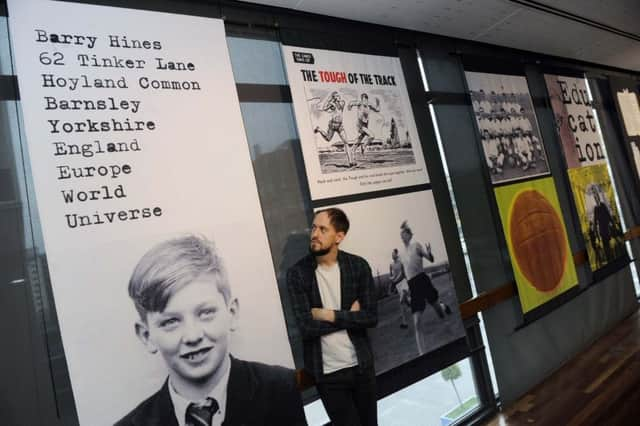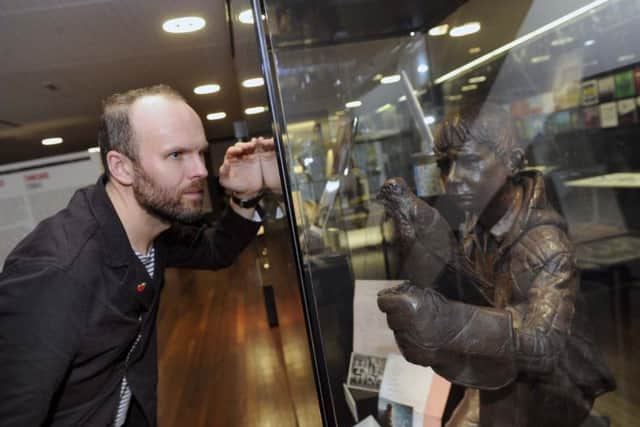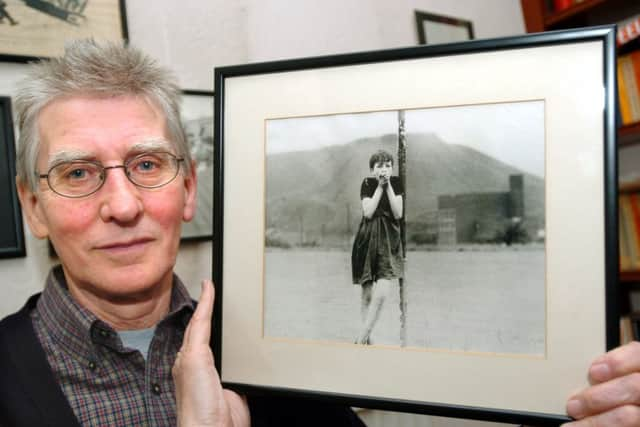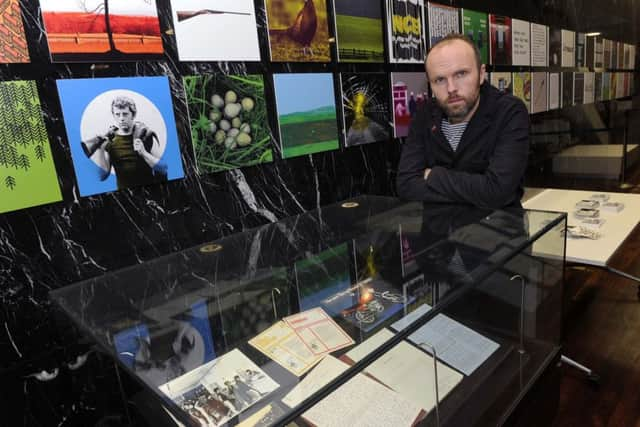The Untameable Barry Hines: Sheffield exhibition shows why Kes and Threads creator’s is needed more than ever


Barry Hines created an enduring working-class hero in the 1960s, was commissioned by film executives to write the British answer to Rocky in the 1970s and scared the nation senseless with a nuclear war drama in the 1980s, but the man from the South Yorkshire pit village of Hoyland Common was never able to forget his roots – not that ever he wanted to.
In 2006, as he planned a move back there after living in Sheffield for 20 years, Hines told The Sheffield Star: “I go back every now and then and people will say ‘Ayup Barry, how tha’ going on’, as if I have never been away. I was in a pub the other week and a bloke said ‘Ayup Barry’, and carried on drinking his pint as though he’d seen me in there the night before. I like that.”


Advertisement
Hide AdAdvertisement
Hide AdHines died in 2016 at 76 several years after being diagnosed with Alzheimer’s disease – leaving behind an astonishing cultural legacy after giving the world both Kes, the story of a young boy’s temporary respite from his troubled life through taming a kestrel, and BBC drama Threads, depicting the terrifying aftermath of nuclear war on the ordinary people of Sheffield.
Now a new exhibition at the University of Sheffield, where the former miner and PE teacher worked during the 1970s, is reassessing his legacy, examining his work beyond his two most famous creations and showcasing a treasure trove of archive material that were donated by Hines and his wife Eleanor to the university before his death.
The Untameable exhibition includes everything from handwritten novel drafts to Hines’s personal copy of a film of a readers’ group from Hoyland Common talking about how his work reflected and influenced their lives. The visually-striking exhibition in the university’s Western Bank Library has been curated by Barnsley artists Patrick Murphy and Anton Want. It is an expanded version of a display they put on at Sheffield’s Festival of the Mind last year.


Dr Dave Forrest, from the university’s School of English, has taken a central role in arranging the exhibition and is a keen student of Hines, co-authoring a book called Barry Hines: Kes, Threads and Beyond with fellow academic Sue Vice in 2017.
Advertisement
Hide AdAdvertisement
Hide AdThe exhibition includes a reading of Hines’s poem A Room With A View by Jon McClure from Sheffield band Reverend and the Makers, as well as quotes from Hines’s work in languages such as German, Hindi, Korean and Mandarin.
“We wanted to get people talking about and thinking about Barry Hines again,” Forrest explains. “What we wanted to do is put it into the present tense and give people a real sense of the contemporary relevance of his work. The story of Kes is just as relevant to someone from Shanghai as it is to someone from Sheffield. It is about loneliness, ambition, education and about engaging with a world beyond your limits.”
Forrest says he has been stunned by the vast impact Hines has had on so many people.


“I have learnt about the power of Barry Hines and writers like him to change people’s lives forever. I can’t count the amount of times when I have been doing public engagement work that I have been told by people ‘that book changed my life, that film changed my life, it made me see differently, it changed my world’. In Kes, that kestrel completely transforms Billy’s world. He is challenging the stereotypes set out before him for his life. That is what we are trying to do with this exhibition.”
Advertisement
Hide AdAdvertisement
Hide AdThe impact of Hines’s work has also been fundamental for Forrest himself.
“I first read Kestrel For A Knave when I was a school pupil at Hemsworth High School in West Yorkshire. It was very much like the landscape you saw depicted in Kes – we all knew a Billy Casper or two or a Mr Sugden. Growing up in the 1990s, it was a writer speaking directly to our experiences and it opened doors to all sorts of arts and culture.
“Kes was owned by people in that community, Hemsworth isn’t far at all from Barnsley and Wakefield.
“Then I watched Threads as a young teenager, not really drawing the connections with Kes. It was again about something very familiar, about Sheffield and seeing these places I knew well on screen made it all the more scary.”
Advertisement
Hide AdAdvertisement
Hide AdThe exhibition focuses on four pieces of work – his 1968 novel A Kestrel for a Knave which became the basis of Ken Loach’s film Kes the following year; television drama Threads and two lesser-known pieces of work – novels The Gamekeeper, about an ex-steel worker who takes on a job of nurturing game so they can be killed by the local Duke, and Looks and Smiles, about two unemployed friends from Sheffield searching for work and meaning to their lives.
While not in the central exhibition, the library’s archive also hosts another fascinating piece of Hines memorabilia – his script for a film called Man of the Match. Hines was hired by film producers in the hope of building on the success of both 1976 boxing underdog film Rocky and rising interest in ‘soccer’ in America following the likes of Pele going to play in the States.
There were even hopes Rod Stewart would star in a Hollywood-backed film – but when Hines turned in a dark script about a Yorkshire footballer struggling with his demons and moving to the US for a fresh start only to be disgusted by the game’s commercialisation, it never got off the ground.
Football was a recurring theme in Hines’s work, who was a talented player himself in his younger years. When he went to Loughborough College to study to become a PE teacher, he played alongside future Arsenal goalkeeper Bob Wilson – as well as gaining inspiration from what would become his first book, The Blinder.
Advertisement
Hide AdAdvertisement
Hide AdForrest says The Blinder started life as Hines’s dissertation, which his forward-thinking lecturers allowed him to make a piece of creative writing. The young Yorkshireman had been inspired to tried his hand at writing after being given George Orwell’s Animal Farm by a friend at Loughborough and it becoming the first book he had read by choice. The Blinder was published two years later in 1966 and tells the story of a promising young footballer whose penchant for getting into trouble also affects his scholastic promise.
Forrest says: “What was really interesting was this tension between football and academic life. Hines writes the football scenes as art, as ballet, showing it as this working class artform.
“On that PE course he was playing in the same football team as Bob Wilson. Bob Wilson later said he had only realised Barry had become a writer when he went to see Kes.”
Forrest says while his political views were at the core of his writing, Hines did not lecture his readers or viewers.
Advertisement
Hide AdAdvertisement
Hide Ad“He was a committed socialist and there is no doubt that is in his work but he was not overly didactic. There was a ‘show, don’t tell’ aspect to it.
“Looks and Smiles is very political, about young unemployed people in Sheffield at the height of Thatcherism. Threads is about how working-class lives are most in the firing line when people in faraway places make remote decisions with devastating effects.
“The feedback he cared about what from the people he depicted in his stories, not middle-class journalists. If a coal miner felt he had got it wrong, that would have really mattered to him.”
Forrest’s introduction to the exhibition says Hines’s legacy as the “quintessential working-class writer” raises uncomfortable questions about whether someone from a similar background could have achieved such success today.
Advertisement
Hide AdAdvertisement
Hide Ad“Nowadays, would a major publisher take a chance on a 25-year-old from Barnsley writing a novel about a teenage footballer?,” it asks. “Would the BBC be knocking on the door of a provincial teacher asking him to write them a film? Would the son of a miner manage to forge a 30-year career writing about ordinary people from South Yorkshire? Sadly I think we know the answers.”
Forrest says that at a time when Hines’ hometown of Barnsley has become a byword for the nation’s divisions on Brexit, voices like his are needed more than ever before.
“We need someone like Barry Hines. While he was deeply political and spoke very passionately for working-class people, he was also doing it in a way that was not reductive, it was rooted in people’s lives and experiences. His books are studies of empathy and shared understanding.
“Barnsley has become a political football for the nation to show how divided we are as a country. It would have been fascinating to see how he would have responded to that. We need writers like him, books and stories are empathy machines with other ways of life. I hope people who visit the exhibition are able to reflect on the importance of telling stories about everyday life – the stuff of life is also the stuff of poetry.”
Advertisement
Hide AdAdvertisement
Hide AdUntameable, at University of Sheffield Western Bank Library, open until December 20, free of charge. Members of the public can also access the archive of his work at the library by appointment.
Dance version of Kes to be shown on television
A dance production of Kes is to be shown on BBC Four next week.
Kes Reimagined was created by award-winning choreographer Jonathan Watkins, who hails from Barnsley himself and was inspired by the book after moving to London at 12 to attend The Royal Ballet School.
Watkins says: “Kes was always in my heart and my head because I grew up in Barnsley. There’s a great message in Kes in terms of finding your path and what you’re passionate about.
Advertisement
Hide AdAdvertisement
Hide Ad“The story has never been autobiographical for me but I found a passion in dance, theatre and telling stories that has led me to where I am. That’s my kestrel.” Kes Reimagined will be broadcast on BBC Four on Tuesday, November 19, at 10pm.